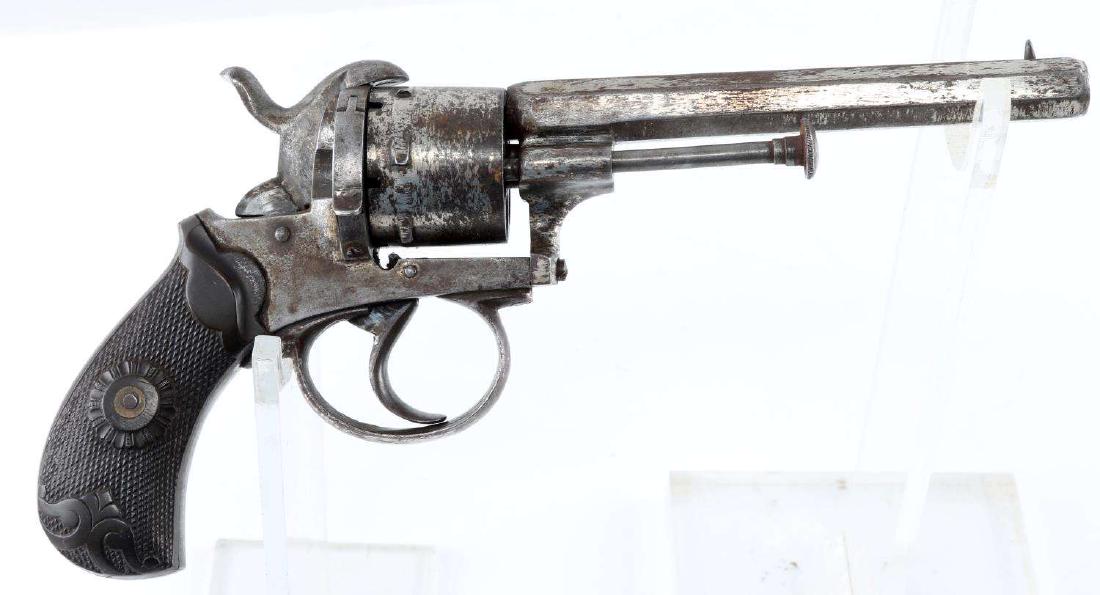

Is an elevated rim on the recoil shield, projecting above the pins to prevent themįrom being hit if the gun is dropped. The patentĭrawings show a revolver clearly patterned after an open-top Colt, with some refinements that the nature of the Eugene Lefaucheux's clever design andĪlso for its inherent drawbacks. The lockwork is exceedingly simple, with only three moving parts toĮffect both double and single-action firing. Have been one at all: many of them were left in the white) but the bore is inĭecent condition and the cylinder locks up. There is no finish left (and there may never Workmanship in these revolvers varies with the maker, but mine is fullyįunctional despite being well over a century old.

Of Belgian "cottage industry" guns of the period) made between 1865 and Little gun is a well-used specimen bearing no indication of who made it (typical Same #11 caps used in muzzle-loading rifles and revolvers, usually readily Loading base, and a small powder measure. Kit comes with 12 re-usable cases, 24 specially-made cast bullets, and the cap holdersĪs well as a threaded rod to position them correctly. et voilà a fully loaded (and theoretically The case, and the bullet seated with the combination seater/sizer die. Special holder (with a slot for the pin) a charge of black powder is put into Turned from solid bar stock), and a "U" shaped cap holder to be inserted intoĪ common #11 percussion cap in the correct position a hole in the "U" correspondsįiring pins pass through the holes, coming to rest on the properly positioned Kit includes a number of heavy-duty brass cases (which appear to be precision Phillipe Vial, was kindĮnough to provide one of his clever self-contained kits in that caliber. Revolver in 7mm, and the owner of the company, M. Pinfire revolvers and also 16 gauge pinfire shotguns. Makes a kit that can be used to prepare cartridges for 7mm, 9mm, and 12mm Had a chance to find out how one stacks up against more modern equivalents. People who own pinfire revolvers asĬuriosities may wonder how effective they were for the intended purpose.

Making cartridges for them: many are goodĬondition and some are positively exquisite examples of gun making. How many of these guns have survived it's a bit surprising that no one is still Is no longer made except in the form of tiny 2mm blanks used in minuscule "key Pinfire guns are encountered only as collector's novelties pinfire ammunition The end of the 19 th Century, the Système Popular for self-defense in a crime-plagued era with few restrictions on the Them were small caliber revolvers (7mm and 9mm) with folding triggers, aįlip-open loading gate and a rod ejector. Thousands were turned out, mostly by the huge Belgian arms industry of the mid Of them, and the Confederate forces somewhere between 20.Īctual number of pinfire handguns made will never be known. Significant role in the American Civil War: the Union forces purchased 11,830 So-called "Model 1854" revolver using the pinfire ammunition his father hadĭerivatives were adopted for military use by many European nations and played a Young) lived to see his invention become a commercial success, it was his sonĮugene (1832-1892, at right) whose patent #19380, issued Novemintroduced the This Système Lefaucheux was a major development in the evolution of small arms. A blow on the pin would detonate the cap and set off the main charge. He received patent #6348 for a tip-up breech loading pistol using a self-contained cartridge in which a pin passed through the outside of the case and rested on a percussion cap enclosed within. The pinfire system of ignition, one of the first practical forms of true fixed ammunition, was the brainchild of Casimir Lefaucheux (1802-1852) a French gunsmith.


 0 kommentar(er)
0 kommentar(er)
